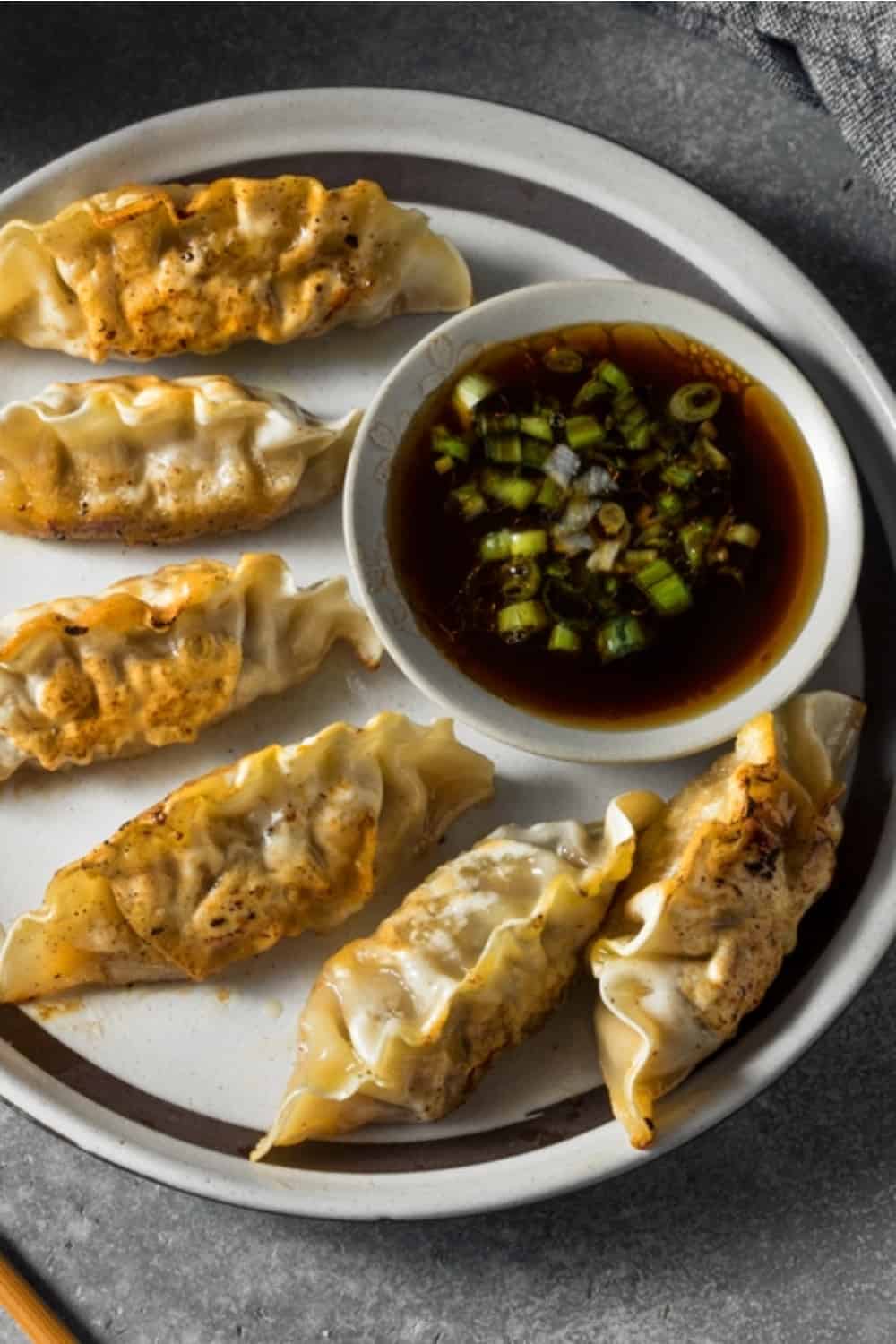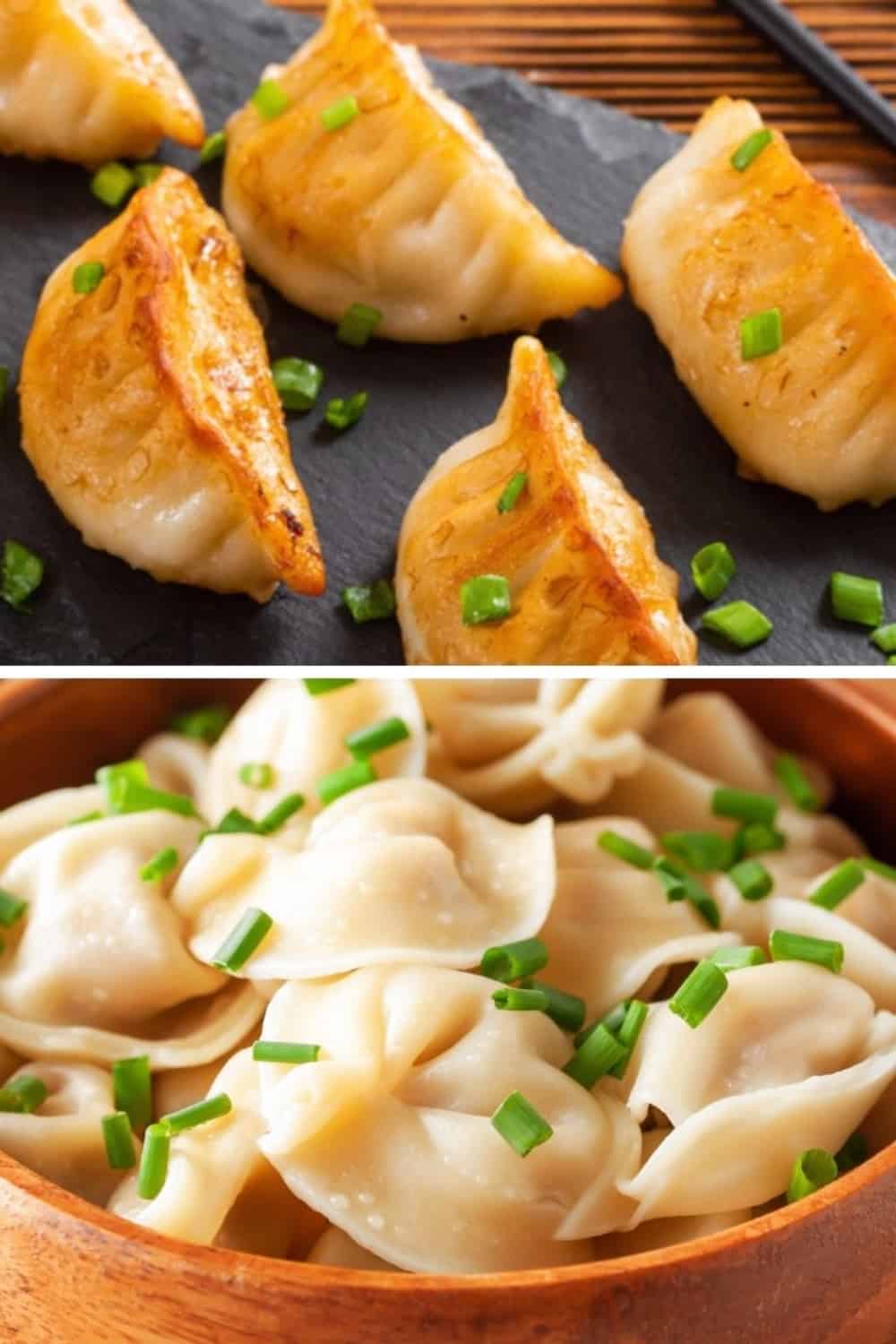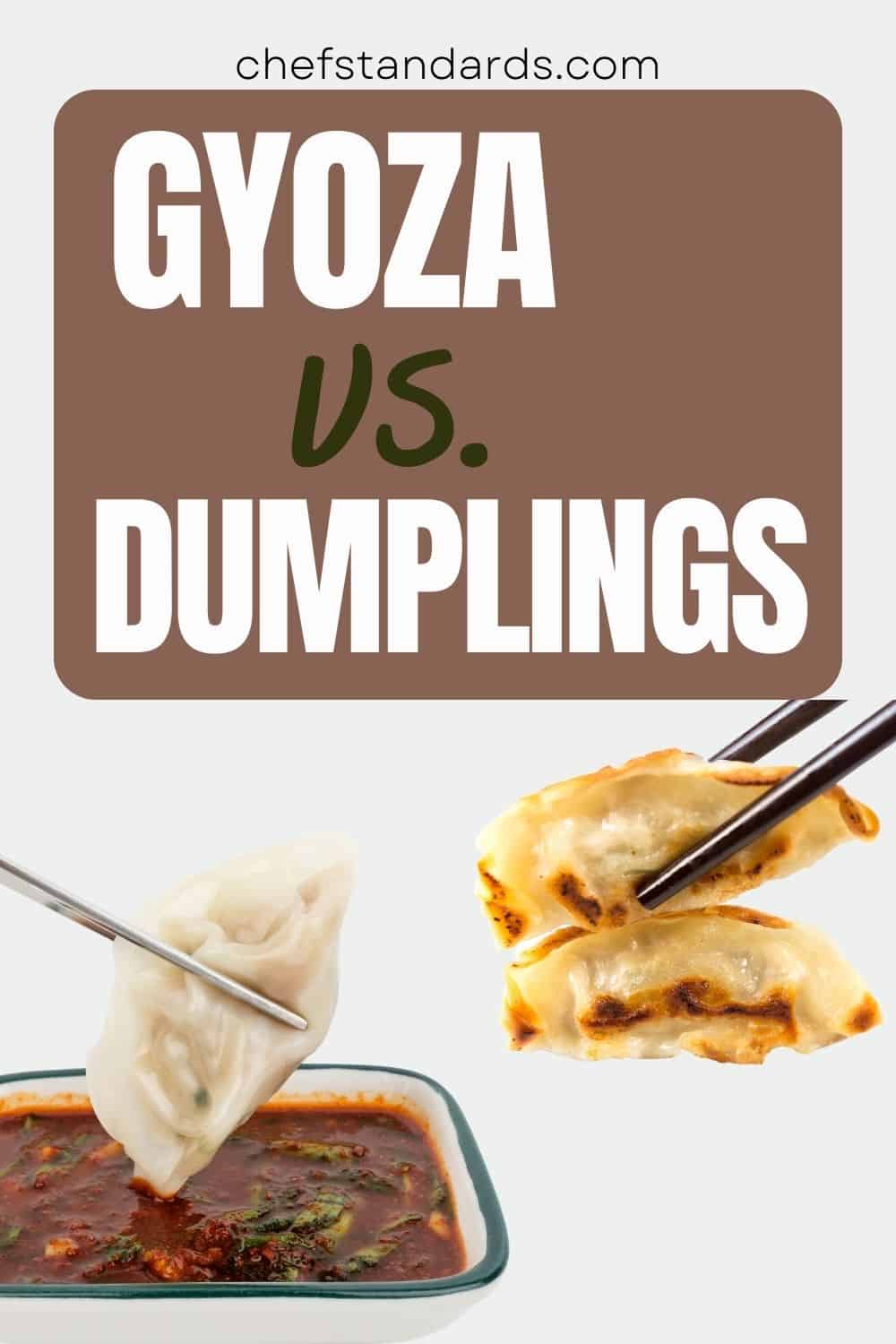I’ve written many articles about comparing two types of food or dishes, but highlighting the differences between gyoza and dumplings has been very tricky.
I am saying this because so many people don’t even know that dumplings is not a single dish, but rather a broad term used to classify any dish made primarily with a piece of dough. And there are so many different types of dumplings.
Gyoza, on the other hand, is in fact a type of dumpling, but most people don’t refer to it as a dumpling, so the question about differences arises easely.
However, this is no surprise since dishes that are primarily called “dumplings” really differ to some extent, from that one type of dumpling that is primarily called “gyoza”.
| GYOZA | DUMPLINGS |
| Broad category of dishes, mostly from Chinese cuisine. | Type of Japanese dumplings. |
| Thin, round, and slightly elastic wrappers. | Thicker wrappers with various shapes. |
| Filling is mostly made from pork meat, vegetables, and various seasonings. | Various types of meat are used, including pork, beef, chicken, or shrimp. |
| Dominant garlic flavor. | More spicy with strong flavors |
| Typically cooked by using a two-step process “sui-gyoza”. | Various cooking methods, including boiling, steaming, or frying. |
| Served with a dipping sauce made from soy sauce, rice vinegar, and sesame oil. | Dipping sauce made from soy sauce, vinegar, and chili oil. |
| Slightly higher in calories because of the pork and cooking method. | Lower in protein. |
All You Have To Know About Dumplings

Dumplings are actually a broad category of dishes found in various cuisines around the world.
You can find this food that starts with D in any continent on the planet and there are so many different types that it is very hard to count them all.
The main characteristic of all types of dumplings is the fact that they are made from dough that is wrapped around some type of filling.
Some dumplings don’t even have fillings at all.
The type of dough and the type of filling is primarily what makes every type of dumpling unique.
The dough is mostly made from wheat flour, but rice flour, potato starch, or even some vegetables can be used for that purpose.
When it comes to the fillings, various types of meats and vegetables are mostly used and the ingredients can be both sweet and savory. Some people add seafood, tofu, various herbs, and spices. There are really no limitations.
Despite all this, I have to emphasize that dumplings are mostly related to Chinese cuisine, and therefore the most popular types come from China.
Although there are many types of fillings that can be used for Chinese dumplings, minced pork meat, and finely-chopped Napa cabbage are usually the main stars.
There are a few popular types of Chinese dumplings.
• Jiaozi (jiǎozi)
• Wonton
• Baozi
• Zongzi
Jiaozi is the most popular type of Chinese dumpling. It is mostly eaten in Northern China, but it has gained popularity all over the country, and even all over Asia.
The most important thing about jiaozi is the fact that it is actually a “twin brother” of gyoza. Why is that so? The explanation is in the section below.
So What Is Gyoza?

Gyoza is a type of Japanese dumpling, but it actually has its origins in China.
Namely, the precursor of gyoza is jiaozi itself. This is why I named it its twin brother.
Jiaozi made their way to Japan through cultural exchange during the 14th century, specifically through trade and interactions with Chinese immigrants.
However, in the 20th century, particularly after World War II, jiaozi became known by the name gyoza thanks to Japanese soldiers who had been in China during the war.
Traditionally, gyoza is filled with minced pork, green onions, and shredded cabbage. However, there are many other ingredients that can be used as fillings, including cheese, shiitake mushrooms, shrimp, or other seafood.
There are several main types of gyoza that can be found in Japan and other parts of the world. These types differ primarily in their fillings, flavors, and cooking methods. Here are some of the main types of gyoza:
• Yaki-Gyoza: Yaki-gyoza is the most common type of gyoza. It is prepared by pan-frying the dumplings until one side becomes crispy and golden brown.
• Sui-Gyoza: Sui-gyoza refers to boiled gyoza. Boiled gyoza have a soft texture and are often served with a dipping sauce.
• Age-Gyoza: Age-gyoza is a variation of gyoza that is deep-fried instead of pan-fried or boiled. Age-gyoza has a crunchy exterior and moist filling.
• Mushi-Gyoza: Mushi-gyoza is a steamed version of gyoza. Steamed gyoza has a softer and more delicate texture compared to those made using other cooking methods.
• Ishi-Yaki Gyoza: Ishi-yaki gyoza, also known as “stone-grilled gyoza”, is a specialty type of gyoza from the city of Utsunomiya in Japan. Ishi-yaki gyoza is typically pan-fried before being transferred to a hot stone plate to finish cooking.
Although many new types of gyoza have developed over the years, traditional or “real” gyoza is always pan-fried, and therefore you will be able to understand the differences between gyoza and dumplings.
6 Main Differences Between Gyoza And Dumplings

Now that you understand the basics of gyoza and dumplings, it is time to learn about the core differences between these two popular Asian dishes.
1. Dough/Wrapper
I will start with gyoza. It typically features a thin, round, and slightly elastic wrapper made from wheat flour.
The dough is rolled out into thin circles and then folded or pleated along the edges to create a crescent or half-moon shape.
When it comes to dumplings, their wrappers are typically thicker. However, dumplings can have a variety of wrapper shapes and textures, depending on the regional style.
Some common shapes include crescent, half-moon, round, or rectangular. The wrappers can be made from various ingredients such as wheat flour, rice flour, potato starch, or even dough made from vegetables like cabbage.
2. Filling
When you fill gyoza, you will typically use ground meat (most commonly pork) mixed with vegetables and various seasonings. The types of vegetables that are mainly used depend on the type of gyoza or personal preferences.
Some of the most commonly used veggies include cabbage, garlic chives, onions, and sometimes garlic or ginger. I have to emphasize that gyoza is usually seasoned with a lot of garlic, which mainly influences its flavor profile.
Some gyoza variations can be filled with various other vegetables, shrimp, and even salmon with a specific mild flavor profile. The mixture for every type of gyoza is usually well-seasoned with soy sauce, sesame oil, salt, and pepper.
The filling for dumplings varies greatly depending on the regional cuisine. It also includes minced meat, but the main difference is the fact that various types of meat can be used, including pork, beef, chicken, or shrimp.
When it comes to other ingredients, like vegetables and seasonings, it is much the same as it is with gyoza. Various veggies can be used, but the ones used most frequently are cabbage, carrots, and mushrooms.
In some cases, tofu is also incorporated, as well as various seasonings, including soy sauce, vinegar, sesame oil, ginger, garlic, or chili. I have to emphasize that the amount of garlic is mostly lower than with gyoza.
3. Flavor Profiles
The most notable difference in flavor between gyoza and dumplings is the fact that the flavors of gyoza are more subtle to suit the Japanese palate.
Since most dumplings are of Chinese origin, Chinese seasonings are often used when making the filling. And you have to know that Chinese seasonings are often more spicy and strong-flavored, which influence the overall flavor profile.
I also have to emphasize that, even though both dumplings and gyoza contain garlic, the garlic flavor is often more dominant in gyoza.
Other flavor differences mostly depend on the type of dumpling. Gyoza is mostly made from pork meat, which gives it a rich, savory taste with a hint of sweetness.
However, dumplings can be made from various types of meat. If they are made with pork meat, they will have a more similar flavor to dumplings. On the other hand, if some other type of meat is used, the flavor will be significantly different.
4. Cooking Method
Starting with gyoza is typically cooked using a two-step process known as “sui-gyoza”. First, the gyoza are pan-fried on one side until the bottom becomes crispy and golden brown.
Water or broth is then added to the pan, and a lid is placed on top to steam the gyoza until they are fully cooked.
When it comes to dumplings, they can be prepared using various cooking methods such as boiling, steaming, frying, or a combination of these techniques.
Boiled dumplings are typically cooked in water until they float to the surface. Steamed dumplings are placed in a steamer basket and then steamed. Fried dumplings can be pan-fried or deep-fried until they become crispy.
Steamed and fried dumplings are quite similar but have some key differences worth knowing.
5. How Are They Served?
I once tried gyoza with its most popular dipping sauce and I was amazed. This dipping sauce consists of a combination of soy sauce, rice vinegar, and sesame oil.
Ingredients like minced garlic, grated ginger, chili oil, or cilantro can also be added for some extra flavor.
You can also try gyoza with some condiments and side dishes to enhance the overall dining experience. Steamed white rice is a popular choice.
You can also try it with pickled vegetables if you want to add a refreshing and tangy element to your meal.
Finally, miso soup also pairs well with gyoza. It is a traditional Japanese soup made with fermented soybean paste.
The accompaniments for dumplings can vary depending on the cuisine. In Chinese cuisine, dumplings are often served with a dipping sauce made from soy sauce, vinegar, and sometimes chili oil.
They may also be enjoyed with condiments like hot mustard or black vinegar. In other cultures, dumplings may be served with various sauces, chutneys, or even in soups.
6. Nutrition
Just like with almost any differentiating factor, most of it depends on the specific type of dumplings. However, I will try to explain some underlying facts.
Since gyoza is mostly made from pork meat, it can provide a significant amount of protein. Dumplings, on the other hand, can vary in protein content depending on the filling.
Vegetable-based dumplings might contain less protein, while meat or seafood-filled dumplings can provide more.
When it comes to fat content, it differs mainly based on the type of filling. Pork-based gyoza may have a higher fat content due to the inclusion of ground pork.
Dumplings with lean meat or vegetable fillings may have a lower fat content, but this can vary based on the specific ingredients used.
If you are concerned about calories, both gyoza and dumplings are moderately calorie-dense due to the combination of carbohydrates from the wrapper and calories from the filling.
However, in most cases, gyoza will be slightly higher in calories because it mostly contains pork meat.
Finally, the cooking method can play a significant role as well. Pan-fried gyoza may have slightly higher fat content compared to boiled or steamed dumplings, as pan-frying typically requires the use of oil or cooking fat.
However, the difference in fat content can be minimized by using healthier cooking oils or alternative cooking methods like steaming or boiling.

